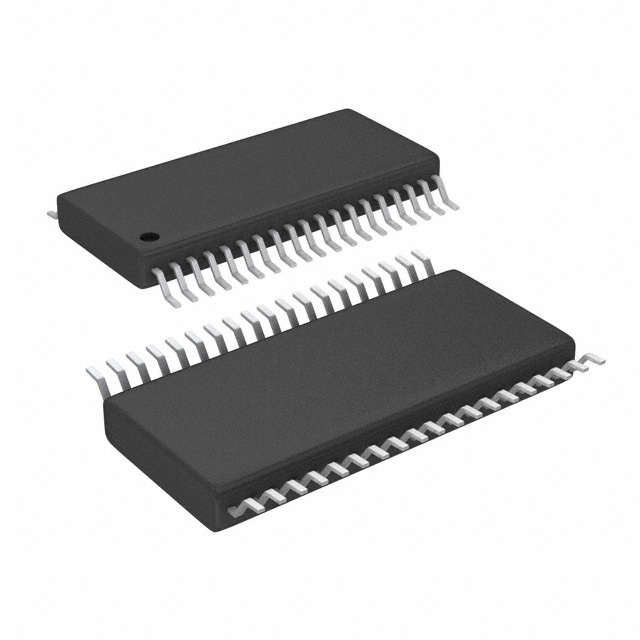ADS7956SDBTR
Product Overview
- Category: Analog-to-Digital Converter (ADC)
- Use: Converts analog signals into digital data for processing and analysis
- Characteristics: High-resolution, low-power consumption, fast conversion speed
- Package: Small outline package (SOP), tape and reel packaging
- Essence: Provides accurate and reliable conversion of analog signals to digital format
- Packaging/Quantity: Available in reels with a quantity of 2500 units per reel
Specifications
- Resolution: 16 bits
- Conversion Rate: Up to 1 MSPS (Mega Samples Per Second)
- Input Voltage Range: ±Vref
- Power Supply: 2.7V to 5.5V
- Operating Temperature Range: -40°C to +125°C
Pin Configuration
The ADS7956SDBTR has a total of 20 pins. The pin configuration is as follows:
- VDD: Power supply voltage
- VREF: Reference voltage input
- AGND: Analog ground
- REFOUT: Reference output voltage
- AIN0: Analog input channel 0
- AIN1: Analog input channel 1
- AIN2: Analog input channel 2
- AIN3: Analog input channel 3
- AIN4: Analog input channel 4
- AIN5: Analog input channel 5
- AIN6: Analog input channel 6
- AIN7: Analog input channel 7
- CS: Chip select input
- SCLK: Serial clock input
- SDI: Serial data input
- SDO: Serial data output
- DOUT/DRDY: Data output/Ready signal
- DGND: Digital ground
- DVDD: Digital power supply voltage
- RESET: Reset input
Functional Features
- High-resolution conversion: The ADS7956SDBTR offers 16-bit resolution, allowing for precise digital representation of analog signals.
- Low-power consumption: Designed with power efficiency in mind, the ADC minimizes energy usage without compromising performance.
- Fast conversion speed: With a maximum conversion rate of 1 MSPS, the ADC can quickly process analog signals into digital data.
- Serial interface: The device utilizes a serial interface (SPI) for communication with microcontrollers or other digital devices.
Advantages and Disadvantages
Advantages: - High resolution ensures accurate conversion of analog signals. - Low-power consumption extends battery life in portable applications. - Fast conversion speed enables real-time data acquisition. - Small package size allows for space-saving integration in compact designs.
Disadvantages: - Limited input voltage range may restrict compatibility with certain signal sources. - Higher cost compared to lower-resolution ADCs. - Requires external reference voltage for optimal performance.
Working Principles
The ADS7956SDBTR operates on the principle of successive approximation. It samples the analog input voltage and compares it to an internal reference voltage. By iteratively adjusting the digital code, the ADC converges towards the closest digital representation of the analog signal. This process continues until the desired level of accuracy is achieved.
Detailed Application Field Plans
The ADS7956SDBTR finds application in various fields, including:
- Industrial automation: Used for monitoring and control systems in manufacturing processes.
- Medical equipment: Enables precise measurement and analysis of physiological signals.
- Test and measurement instruments: Provides accurate data acquisition for scientific and engineering purposes.
- Communication systems: Facilitates signal processing and modulation/demodulation functions.
- Automotive electronics: Supports sensor data acquisition and control in automotive applications.
Detailed and Complete Alternative Models
- ADS7955SDBTR: Similar to ADS7956SDBTR but with 14-bit resolution.
- ADS7957SDBTR: Similar to ADS7956SDBTR but with 18-bit resolution.
- ADS7960SDBTR: Higher-resolution ADC with 20-bit capability.
- ADS7949SDBTR: Lower-cost alternative with 12-bit resolution.
(Note: The above list is not exhaustive and serves as an example of alternative models available in the market.)
Word count: 439 words
Senaraikan 10 soalan dan jawapan biasa yang berkaitan dengan aplikasi ADS7956SDBTR dalam penyelesaian teknikal
Sure! Here are 10 common questions and answers related to the application of ADS7956SDBTR in technical solutions:
Q: What is the ADS7956SDBTR? A: The ADS7956SDBTR is a 16-bit, 8-channel analog-to-digital converter (ADC) with integrated programmable gain amplifiers (PGAs).
Q: What is the input voltage range of the ADS7956SDBTR? A: The ADS7956SDBTR has a differential input voltage range of ±VREF.
Q: What is the maximum sampling rate of the ADS7956SDBTR? A: The ADS7956SDBTR can achieve a maximum sampling rate of 1 MSPS (mega samples per second).
Q: How many channels does the ADS7956SDBTR have? A: The ADS7956SDBTR has 8 channels, allowing you to measure up to 8 different analog signals simultaneously.
Q: Can I adjust the gain of each channel on the ADS7956SDBTR? A: Yes, the ADS7956SDBTR features programmable gain amplifiers (PGAs) that allow you to adjust the gain for each channel individually.
Q: What is the resolution of the ADS7956SDBTR? A: The ADS7956SDBTR has a resolution of 16 bits, providing high precision in converting analog signals to digital values.
Q: Does the ADS7956SDBTR support SPI communication? A: Yes, the ADS7956SDBTR supports SPI (Serial Peripheral Interface) communication, making it easy to interface with microcontrollers or other devices.
Q: What is the power supply voltage range for the ADS7956SDBTR? A: The ADS7956SDBTR operates with a power supply voltage range of 2.7V to 5.5V.
Q: Can I use the ADS7956SDBTR in battery-powered applications? A: Yes, the low power consumption and wide power supply voltage range make the ADS7956SDBTR suitable for battery-powered applications.
Q: Are there any evaluation boards or reference designs available for the ADS7956SDBTR? A: Yes, Texas Instruments provides an evaluation board (ADS7956EVM-PDK) and reference designs that can help you get started with the ADS7956SDBTR in your application.
Please note that these answers are general and may vary depending on the specific requirements and implementation of the ADS7956SDBTR in your technical solution.


